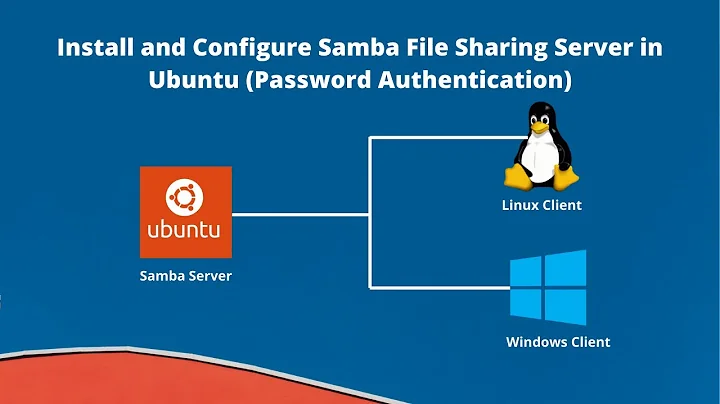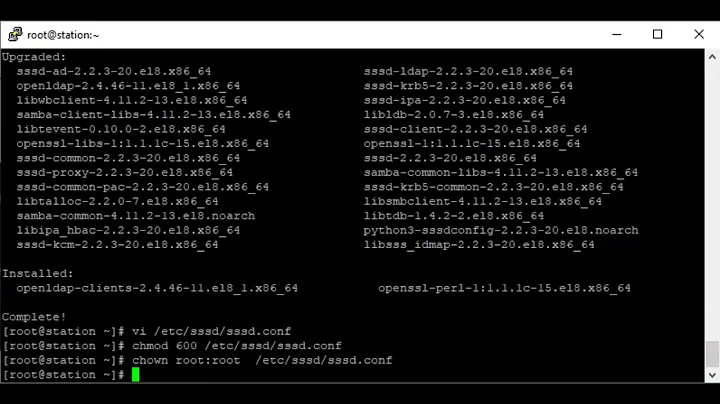Can't add local user on system using ldap auth for samba
Solution 1
Neither of these two workarounds are optimum, but they do give sysadmins a way of moving forward if they find themselves in the sticky situation where LDAP and the local passwd file are blocking each other.
Workaround 1: I created a local user with a different UID (username) to give ssh access to a person who already had an LDAP/Samba entry. Possibly the cheeziest sysadmin solution I've done in years.
Workaround 2: A little more complicated but comes down to adding the local user with the same uidNumber as in LDAP.
- Lookup LDAP uidNumber with getent, ldapsearch, or smbldap-usershow
- Temporarily disable the user in LDAP in order to add the local user without conflicts
- Create the local account matching the uidNumber with LDAP
- Re-enable the user in LDAP
Both of these work, but neither address the underlying issue of allowing the authentication to use LDAP exclusively for Samba auth and /etc/passwd for local auth. But in the absence of another solution, this will have to do.
Solution 2
My last answer was bad, ignore that.
I believe your only option is manual editing of /etc/passwd (vipw is preferred because it saves you from your own mistakes). The -o option allows you to create multiple names for one UID, but there isn't an equivalent option for telling passwd to ignore the name already existing when it performs a NSS lookup.
getent passwd will show you how the uids cascade once you've added the user; the first entry wins. Make sure the uid is identical to avoid issues with shifting permissions. (your examples did not include -u syntax)
Related videos on Youtube
Wes Modes
Wes Modes is a Santa Cruz artist and art researcher working in the Digital Art and New Media program at the University of California Santa Cruz. In various lives, he is a sculptor, writer, performer, community organizer, programmer, geek, and mischief-maker. Current projects: Secret History is a journey to discover and collect the lost narratives of people who live and work on the river from the deck of a recreated shantyboat and present these stories through web-based digital archives and a touring art installation. http://peoplesriverhistory.us Co-related Space is a digitally-enhanced environment that highlights participants’ active engagement and experimentation with sound and light, including complex direct and indirect behavior and relationships. Using motion tracking, laser light projection and a generative soundscape, it encourages interactions between participants, visually and sonically transforming a regularly trafficked space. http://corelatedspace.com
Updated on September 18, 2022Comments
-
Wes Modes over 1 year
Trying to add a local user to a CentOS 6.3 system that is using ldap for Samba authentication, but being stymied by the user's existing entry in ldap.
[root@samba ~]# adduser wchandy adduser: user 'wchandy' already exists [root@samba ~]# useradd wchandy useradd: user 'wchandy' already existsUser is not already a local user:
[root@edgar2 ~]# grep wchandy /etc/passwdBut they are a Samba user in ldap:
[root@edgar2 ~]# smbldap-usershow wchandy | grep uid dn: uid=wchandy,ou=people,dc=ucsc,dc=edu uid: wchandy uidNumber: 30490adduser does not have a local option. How does one get adduser to work properly to add local users in the presence of ldap authentication.
Other things to consider:
- There are currently local users who share a uid with an ldap entry (with a different uidNumber) who can access samba and ssh independently.
- No, I don't want to edit the user directly into /etc/passwd and /etc/group. I'd like to fix the underlying problem. Plus the local entry interferes with access to samba.
- No, I don't want to rely on ldap for local ssh login.
- No, I don't want to use a different uid for the user.
I originally set up my samba-ldap authentication with the handy (but seemly irreversible) authconfig command:
[root@samba ~]# authconfig --enableshadow --enablemd5 --enableldap \ --enableldapauth --enableldaptls --enablemkhomedir \ --ldapserver=dir.mydomain.com --ldapbasedn="dc=mydomain,dc=com" \ --enablelocauthorize --updateallMy /etc/sysconfig/authconfig looks like this:
IPADOMAINJOINED=no USEMKHOMEDIR=yes USEPAMACCESS=no CACHECREDENTIALS=yes USESSSDAUTH=no USESHADOW=yes USEWINBIND=no PASSWDALGORITHM=sha512 FORCELEGACY=no USEFPRINTD=yes USEHESIOD=no FORCESMARTCARD=no USEDB=no USELDAPAUTH=yes IPAV2NONTP=no USELDAP=yes USECRACKLIB=yes USEIPAV2=no USEWINBINDAUTH=no USESMARTCARD=no USELOCAUTHORIZE=yes USENIS=no USEKERBEROS=no USESYSNETAUTH=no USESSSD=no USEPASSWDQC=noMy samba config was migrated from an RHEL4.x system to CentOS 6.3. Now instead of the kludgy mashup of nss and pam and who knows what, CentOS 6.x uses the pretty slick and easy sssd.
My /etc/sssd/sssd.conf looks like this:
[domain/default] cache_credentials = True #cache_credentials = False ldap_search_base = dc=mydomain,dc=com krb5_realm = EXAMPLE.COM krb5_server = kerberos.example.com id_provider = ldap auth_provider = ldap chpass_provider = ldap ldap_uri = ldap://dir.mydomain.com/ ldap_tls_cacertdir = /etc/openldap/cacerts #ldap_tls_reqcert = allow entry_cache_timeout = 5 debug_level = 31 [sssd] config_file_version = 2 services = nss, pam # SSSD will not start if you do not configure any domains. # Add new domain configurations as [domain/<NAME>] sections, and # then add the list of domains (in the order you want them to be # queried) to the "domains" attribute below and uncomment it. # domains = LDAP domains = default #debug_level = 31 [nss] [pam] debug_level = 31Thanks for the help. If I can get my local and samba-ldap authentication working independently I'll be stoked.
UPDATE: While there are some reasonably sufficient workarounds below, here's a parapharse of the advice I got from the experts at the sssd_users list: "Yes, it may have worked in earlier OS versions using nss and pam, it wasn't the best practice to allow shared UIDs. Newer systems using sssd prevent this." While my use case was perfectly valid, my system prevented what I wanted to do by intention.
However, I never did find a way to unset or reverse any of the many changes that authconfig wrought to my system. So if the parameters I gave to authconfig were wrong, there was no going back.
-
Andrew B almost 11 yearsKeep in mind that sssd is consumed by NSS and PAM; it does not replace them. You still need to understand those services and how they interact with it.
-
Wes Modes over 10 yearsI am definitely not an NSS, PAM, or sssd expert, I feel like I should still be able to effectively configure it. No answer to this question has yet been offered.
-
Wes Modes over 10 yearsThis does not answer the original inquiry, but I had to find some temporary workaround: I created a local user with a different UID to give ssh access to a person who already had an LDAP/Samba entry. Possibly the cheeziest sysadmin solution I've done in years.
-
Wes Modes over 10 yearsOkay another workaround, still less than optimal: Adding the local user with the same uidNumber as the LDAP entry. That allows both local and Samba access.
-
Andrew B over 10 yearsFixing the underlying problem unfortunately means working with the software authors or submitting a patch yourself. We cannot help you do something that the command simply does not support.
-
Andrew B over 10 yearsAdditionally, your edit now adds conflicting logic: you want the useradd command to work despite the duplicate username, but adding local entries manually interferes with samba? Please edit your question to focus on the specific problem you want solved.
-
Wes Modes over 10 yearsAndrew, I appreciate your taking the time to respond, and I don't think the request is unreasonable nor confusing. To be concise: I want to know how to configure sssd, nss, and pam (preferably with the authconfig tool) to allow local authentication exclusively from /etc/passwd while allowing Samba to use LDAP exclusively for authentication. In fact, I had a RHEL4 system configured precisely this way.
-
Wes Modes over 10 yearsAnd I strongly believe this is a configuration issue, a gap in my understanding of the complex systems involved, not a software engineering issue. The authors would no doubt have an answer to my query, and perhaps that is where I should seek. There is a mailing list for sssd users.
-
Andrew B over 10 yearsAt least for me, the presentation wasn't very clear. Between the subject and How does one get adduser to work properly to add local users in the presence of ldap authentication., your intent shifts more toward "how do I get useradd to let me do this" than "how do I dis-entangle these two services". If you edit the question to focus on your actual intent from the beginning, it'll probably pass the re-open queue and we'll take another shot at it.
-
Wes Modes about 10 yearsNo I don't think this question was unclear. I edited the title to better reflect the problem.
-
Andrew B about 10 yearsLooking at things again I think I have a better idea of what you're looking for; I just think we were just talking around each other in circles. Drop by this SF chat if you still need help and we'll work it out without spamming this question.
-
Wes Modes about 10 yearsThanks, Andrew. The workarounds were sufficient. It's been a while, but I believe the answer I finally got from the sssd_users list is: "Yes, it may have worked in earlier versions, but it wasn't the best practice to allow shared uids. Newer versions prevent this." While my use case was perfectly valid, sssd (which replaced some of the other systems cobbled together with dental floss and chewing gum) doesn't allow it." In fact, I should add this to the original question. Thanks!
-
Andrew B about 10 yearsIf you need to untie
passwdlookups from sssd, remove sssd from the corresponding entry in/etc/nsswitch.conf(unless there's a daemon that breaks by doing this). You really can't get away from understanding NSS and PAM when doing elaborate overlays. sssd is implemented by modules for both, and is not a replacement.
-
Wes Modes over 10 yearsPlease see above: "No, I don't want to edit the user directly into /etc/passwd and /etc/group. I'd like to fix the underlying problem. PLUS THE LOCAL ENTRY INTERFERES WITH ACCESS TO SAMBA." So, unfortunately, no, that isn't a solution.




